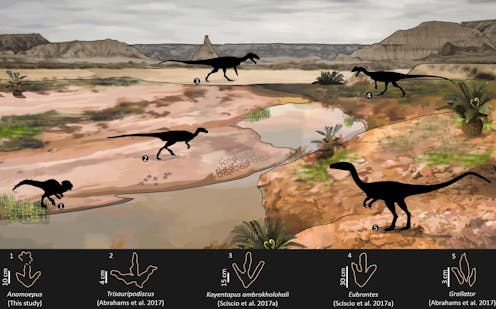
I am a poor navigator. This is not an easy thing for a field geologist to admit. We need to be able to find our planned area of interest in good time and make our way back to our potentially hidden and distant vehicles at the end of the day. It’s especially true that I am a poor navigator when I need to use nondescript bushes, the distant hill shape, and the odd fallen boulder as reference points.
So it was no surprise when I led my MSc student Loyce Mpangala and our PhD candidate field assistant Akhil Rampersadh astray in Lesotho’s Roma Valley. We were walking back to our car after looking at a dinosaur tracksite that I’d visited before. The tracksite, which is marked on Google Maps as an attraction, was on the other side of a sparsely populated hill with numerous informal walkways, overlooking the National University of Lesotho.
Walking along the wrong (I didn’t know it then) footpath, I spotted a dinosaur footprint I hadn’t seen before. Once you’ve worked on dinosaur tracks for seven years and visited the same site a few times you get to know their shape and their personality. And this one was different. The first footprint I spotted superficially resembled others on the hill: three-toed, longer-than-wide with claw marks; but it was far away from the known site we had just visited.
After taking a few more steps, we spotted some more footprints. These had distinct shapes we had not yet seen in the Roma area: short, wide footprints with rounded, stubby toes. When we looked more closely, they were sometimes paired with star-shaped handprints. These footprints were made by herbivorous ornithischian dinosaurs and it is the first time their distinct shape has been documented in the Roma Valley, which is rich in fossil footprints. It adds to scientists’ knowledge of the extensive trace fossil diversity of the local dinosaur community during the Early Jurassic period about 200 million years ago.
I guess sometimes – and I cannot overemphasise how rarely – the wrong turn can lead you to the right place.
New, old and very old
The tracksite was new to our dino-tracking team from South Africa’s University of Cape Town. But it was not a new discovery. It is known as the Mokhosi site and was reported in 2003 by David Ambrose, a tracking enthusiast and mathematics professor at the National University of Lesotho. He noted that a number of large three-toed prints were preserved, with more likely to be beneath the recent sand covering.
Our extensive uncovering (a glamorous way for saying sweeping) of the 18 metre by 2 metre tracksite showed that more fossil evidence had indeed been captured in the rock. We documented 35 footprints; most were part of trackways, heading in all directions.
The footprints were all three-toed and fell into two main shape groupings – those that were longer-than-wide, with slender toes and sharp claw marks, and those that were wider-than-long, with robust, rounded toes. The latter were occasionally associated with smaller and shallow handprints, in front and slightly to the outer side of their corresponding footprints.
The first group of tracks (longer-than-wide) are a type commonly preserved in southern Africa and can be attributed to carnivorous theropod dinosaurs. The theropod tracks at Mokhosi reach a maximum length of about 40cm, meaning that these meat-eating travellers would have had a hip height of about 2 metres, towering over humans.
Read more: Footprints take science a step closer to understanding southern Africa's dinosaurs
The second group of hand- and footprints preserve characteristics consistent with herbivorous ornithischian dinosaur trackmakers. Our excitement rose as we carefully dusted these tracks: globally, ornithischian footprints are rarer than theropods during the Early Jurassic.
This marks the first time these distinct quadrupedal ornithischian footprints have been found in the Roma Valley. It’s remarkable, given that a high number of tracksites (14) have been identified and studied in the area.
Waiting to be found again
When we walked back to our car after a long day, we took a moment to stare back at the wonderful site we’d stumbled across. We knew that the future rains and winds would once again hide the Mokhosi tracksite, leaving only small clues to the keen eye of what lies beneath the sand.
We wish the same excitement to the next passerby who unveils this little wonder.
To help you, I’d like to note that the nearby bush is “bushier than the surrounding ones”, that the hill gradient “changes ever so slightly above the track-bearing sandstone”, and that the nearby boulders are completely “nondescript”.
The research component of this project was supported from the following research grants obtained by MA: DSI-NRF Centre of Excellence Genus (grant number 86073); NRF Thuthuka (grant number 138151); UCT Research Development Grants 2020 – 2021. AR is a recipient of postgraduate funding from the DST-NRF Centre of Excellence in Palaeoscience (Genus). LM is a recipient of postgraduate funding from the DST-NRF Centre of Excellence in Palaeoscience (Genus) and Palaeontological Scientific Trust (PAST), Johannesburg, South Africa; DSI-NRF Centre of Excellence in Palaeoscience.
This article was originally published on The Conversation. Read the original article.







